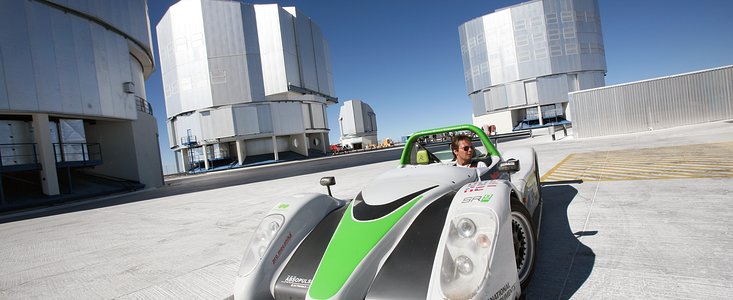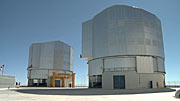Announcement
Electric Supercar on Pan-American Marathon Races to ESO’s Very Large Telescope
28 October 2010
The SRZero supercar, one of the most advanced electric vehicles ever created, sped to the European Southern Observatory’s Very Large Telescope on 27 October as part of its ambitious trek down the Americas. This was a remarkable meeting of two technological masterpieces that are both examples of the finest inventions that have taken humanity to the limits of the possible, both on this planet and beyond. Astronomers, journalists, engineers and other lucky guests enjoyed the extraordinary spectacle of this eco-friendly supercar revving around the four Unit Telescopes, bathed in glorious sunset light before the observatory domes opened to begin the night’s observations.
The SRZero electric supercar is a project carried out by students from the Racing Green Endurance (RGE) team from Imperial College London’s Energy Futures Lab, sponsored by KPMG and supported in Chile by the British Embassy. The 400-bhp twin-motor vehicle is touring the full 26 000 km length of the Pan-American Highway from Alaska's Prudhoe Bay, to Ushuaia, one of the southernmost cities in the world. This route is an immense challenge for road vehicles, and so is the perfect testbed to show how electric cars are every bit as capable as their conventional counterparts.
The European Southern Observatory (ESO) Very Large Telescope is the world’s most advanced visible-light astronomical observatory, and the flagship facility for European ground-based astronomy. It consists of four immense Unit Telescopes that allow astronomers to peer into the depths of the cosmos, revealing distant objects such as galaxies that are four billions times fainter than those which can be seen with the unaided eye.
“Visiting ESO’s Very Large Telescope was definitely a highlight of the expedition. We were very happy to see that ESO shares our enthusiasm for education, though in different areas, but after meeting the astronomers it became clear that we also have a common passion for adventure. While we experiment with new propulsion methods to push the boundaries of what can be achieved with electric vehicles, they use advanced technology to explore the Universe and reach new heights in astronomy,” said Alexander Schey, Racing Green Endurance Project Manager.
Sustainability is essential for astronomers living and working at Paranal Observatory, home to the Very Large Telescope. In the forbidding desert environment, virtually nothing can grow outside. The humidity drops below 10 percent, there are intense ultraviolet rays from the Sun, and the high altitude leaves people short of breath. To allow the scientists some respite, they stay in a modern hotel called the Residencia. This award-winning construction was designed by German architects Auer+Weber as a subterranean L-shape, with a 35-metre dome covering an indoor garden. The use of natural materials and colours means that the Residencia blends smoothly into the Atacama’s landscape. Its futuristic looks landed it a role as a villain’s hideout in the recent James Bond film Quantum of Solace!
More information
ESO, the European Southern Observatory, is the foremost intergovernmental astronomy organisation in Europe and the world’s most productive astronomical observatory. It is supported by 14 countries: Austria, Belgium, Czechia, Denmark, France, Finland, Germany, Italy, the Netherlands, Portugal, Spain, Sweden, Switzerland and the United Kingdom. ESO carries out an ambitious programme focused on the design, construction and operation of powerful ground-based observing facilities enabling astronomers to make important scientific discoveries. ESO also plays a leading role in promoting and organising cooperation in astronomical research. ESO operates three unique world-class observing sites in Chile: La Silla, Paranal and Chajnantor. At Paranal, ESO operates the Very Large Telescope, the world’s most advanced visible-light astronomical observatory and VISTA, the world’s largest survey telescope. ESO is the European partner of a revolutionary astronomical telescope ALMA, the largest astronomical project in existence. ESO is currently planning a 42-metre European Extremely Large optical/near-infrared Telescope, the E-ELT, which will become “the world’s biggest eye on the sky”.
The international firm KPMG is the main sponsor of the RGE project. In Chile, KPMG and the British Embassy have carefully followed the vehicle since its arrival in the Americas, working together to make sure that the project has the greatest impact possible in the country. Both KPMG and the British Embassy in Chile are proud to introduce to the local community a vehicle that presents sustainable features and breakthrough technology in line with the significant advances made in the country during recent years.
Links
Contacts
Gonzalo Argandona
ESO Santiago Office
Phone: +56 2 463.3258
E-mail: gargando@eso.org
Oana Sandu
ESO, Garching, Germany
Community and Outreach Support
Phone: +49 89 3200 6965
E-mail: osandu@eso.org
About the Announcement
| Id: | ann1079 |


